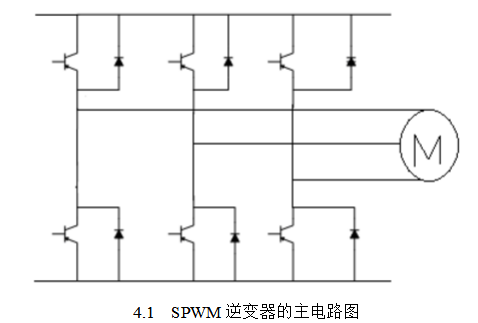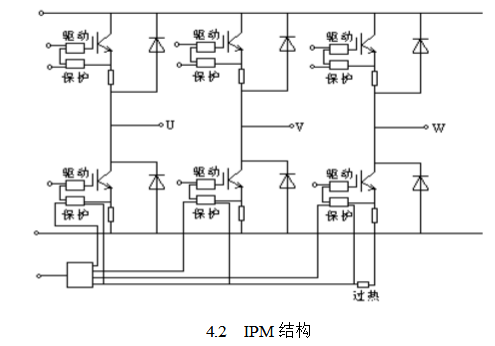The SPWM (Sinusoidal Pulse Width Modulation) technique is a well-established method that has become widely adopted in modern power electronics. A key insight from sampling control theory is that narrow pulses with equal area but different shapes produce similar effects when applied to systems with inertia. This principle underpins the SPWM approach, which generates a pulse waveform that closely resembles a sine wave. By controlling the on and off states of switching devices in an inverter circuit, SPWM ensures that the pulse voltage output has the same area as the corresponding sine wave segment over each interval. This allows for precise adjustment of both the frequency and amplitude of the inverter’s output voltage by modifying the modulating signal.
**Structure of Three-Phase SPWM Inverter**
The main circuit of an SPWM inverter is essentially similar to that of a standard PWM inverter. However, instead of using thyristors, it typically employs IGBTs (Insulated Gate Bipolar Transistors) in a voltage-type PAM configuration. In SPWM, the voltage switches direction rapidly, while the half-wave remains unidirectional. As a result, the output voltage and current may not always align in direction. To address this, freewheeling diodes are incorporated to provide a path for the reverse current. With the addition of a three-phase inverter bridge equipped with these diodes, the basic structure of the SPWM inverter is formed. Figure 4.1 illustrates the main circuit, consisting of six IGBTs arranged in a three-phase bridge, each paired with an anti-parallel diode.

IGBTs require specific drive and protection circuits for proper operation. In practice, they are often integrated into intelligent power modules (IPMs), which include built-in drive and protection features. IPMs also offer overheat protection for the entire module. For smaller capacities, IPMs may be designed as multi-cell structures, such as six-cell or seven-cell modules. The six-cell IPM integrates a complete SPWM inverter, as shown in Figure 4.2. The seven-cell version includes additional components for energy-consuming braking.

As seen in Figure 4.2, the six-cell module has five main terminals: DC positive and negative input, and three-phase AC output. It also features several control terminals for driving and protection, which can interface directly with a conventional control chip or through optical coupling. The driving terminal receives external signals, while the protection terminal sends alerts to the controller when action is needed. The main circuit terminals are usually mounted as terminal blocks, and the control terminals are often grouped in concentrated jacks. The seven-cell IPM adds a braking resistor connection and its corresponding control terminal.
When dealing with larger capacities, integrating the entire inverter into a single IPM module becomes less practical. This leads to two major drawbacks: increased size and weight, which complicate installation and heat dissipation, and higher replacement costs if any component fails. Therefore, for high-capacity applications, IPMs are often split into two or even one-unit configurations. A two-unit IPM contains all the components of one inverter leg, including two IGBTs, freewheeling diodes, and their associated drive and protection circuits. A single-unit IPM consists of just one IGBT, its freewheeling diode, and the necessary drive and protection circuits.
In addition to the main inverter circuit, a snubber circuit is often required to limit the rate of voltage change across the IGBTs. This circuit, along with the drive and protection circuits, plays a critical role in ensuring reliable and efficient operation.
**Four Key Features of SPWM Inverter**
Although square wave inverters are simple to implement, their high harmonic content makes them unsuitable for most applications. They are only used in very limited cases where harmonics are not a concern. Since the introduction of sinusoidal pulse width modulation, inverter technology has advanced significantly. With the widespread use of DSP chips, inverter systems have become more digital and intelligent.
The SPWM inverter offers the following advantages:
1. **Simple Circuit Design**: The main circuit is similar to that of a square wave inverter, but it allows for adjustable output voltage, frequency, and phase with just a single power level.
2. **Independent Power Factor**: An uncontrollable rectifier bridge can be used, making the system's power factor independent of the inverter's output voltage.
3. **Simultaneous Frequency and Voltage Control**: It enables both frequency modulation and voltage regulation without being affected by the original parameters of the system or the dynamic response speed.
4. **Low Harmonic Distortion**: SPWM produces very low harmonic content, with harmonics distributed symmetrically around the carrier frequency. SPWM stands for Sinusoidal Pulse Width Modulation, a technique derived from communication modulation methods. It works by comparing a reference (modulating) sine wave with a high-frequency triangular wave, generating a series of rectangular pulses whose widths vary according to the reference wave. These pulses are then used to control the switching of the transistors, producing an output waveform that closely matches the desired sine wave.
CPVC Sheet Conical Twin Screw Extrusion Line
High Capacity Cpvc Sheet Conical Twin Screw Extrusion Line,Precision Cpvc Sheet Conical Twin Screw Extrusion Line,Affordable Cpvc Sheet Conical Twin Screw Extrusion Line,Customizable Cpvc Sheet Conical Twin Screw Extrusion Line
Zhejiang IET Intelligent Equipment Manufacturing Co.,Ltd , https://www.ietmachinery.com